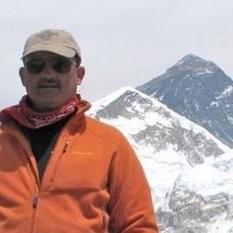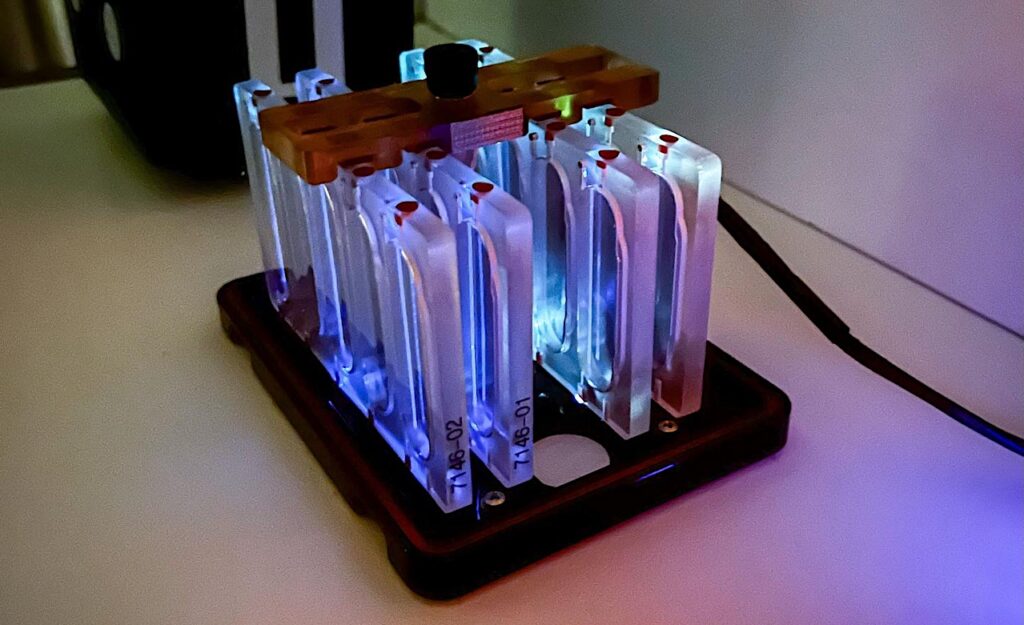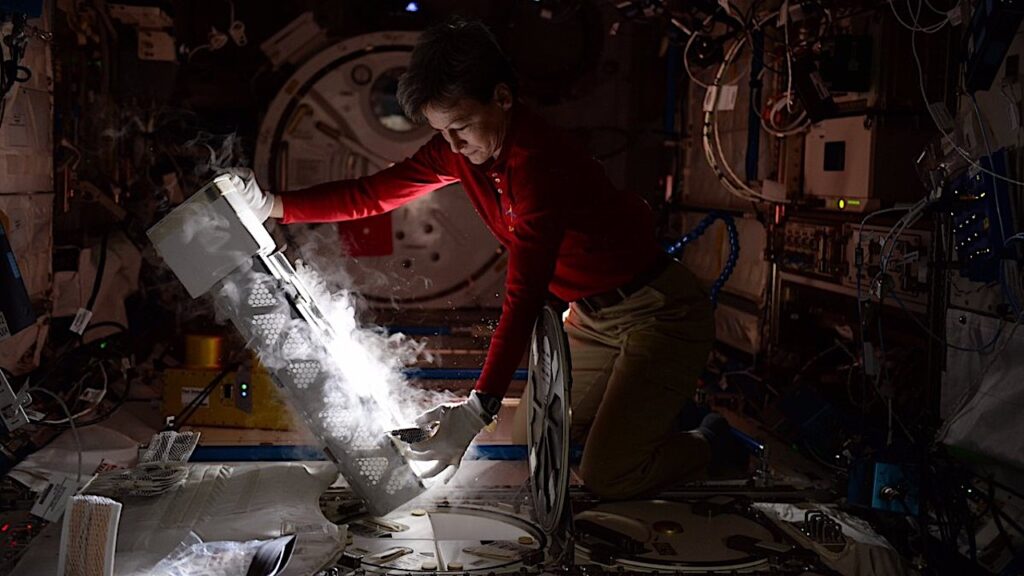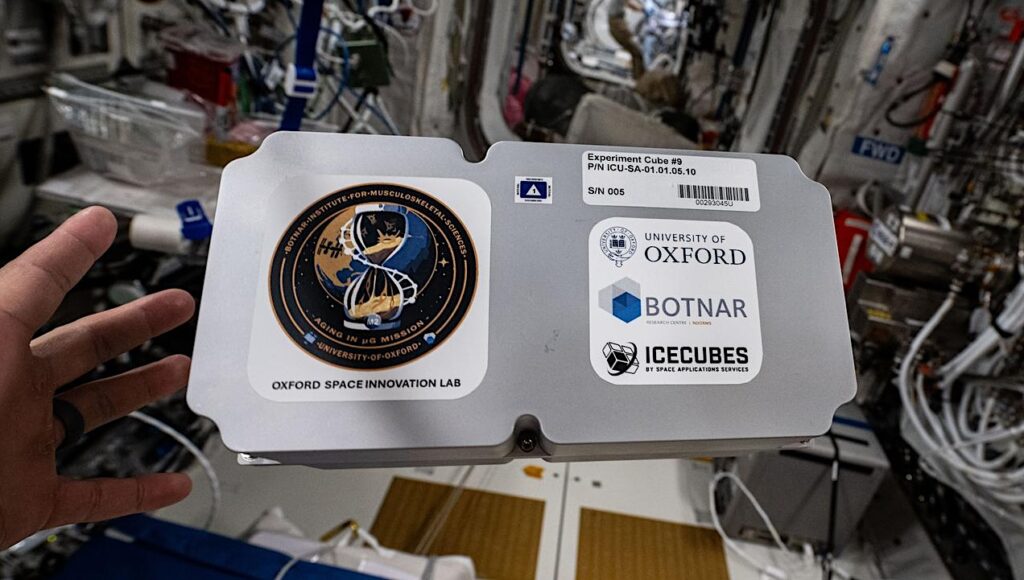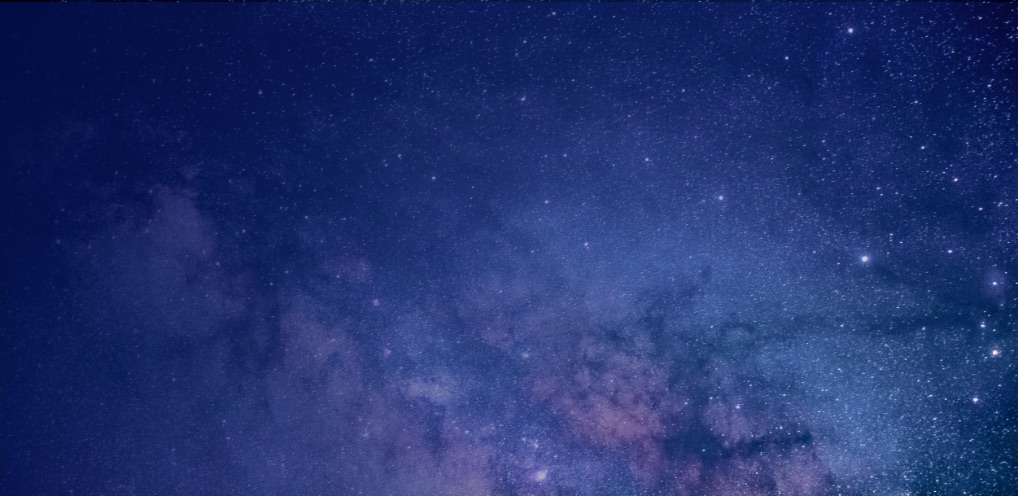NASA Spaceline Current Awareness List #1,138 28 February 2025 (Space Life Science Research Results)

NASA Spaceline Current Awareness List — Grok via Astrobiology.com
The abstract in PubMed or at the publisher’s site is linked when available and will open in a new window.
Papers deriving from NASA support:
- Moestl S, De Boni L, Hoenemann J-N, Kramer T, Schmitz J, Pesta D, Frett T, Bohmeier M, Frings-Meuthen P, Ewald AC, Nitsche A, Loehr P, Noppe A, Klischies N, Huang AS, Laurie SS, Marshall-Goebel K, Macias BR, Tank J, Jordan J, Mulder E.Mechanical countermeasures for spaceflight-associated neuro-ocular syndrome during 30-days of head down tilt bedrest: design, implementation, and tolerability.Front Physiol. 2025 Feb 23;16:1530783.Note: From the abstract: “After longer duration space missions, some astronauts experience structural and functional changes in the eye and structural changes in the brain, termed Spaceflight-Associated Neuro-Ocular Syndrome (SANS). Countermeasures against SANS are required to minimize potential operation impacts and negative long-term health consequences. Headward fluid shifts, which appear to promote SANS, provide a target for countermeasures. The SANS countermeasures study, a 30 days strict head-down tilt bedrest (HDTBR) study, tested two mechanical countermeasures aimed at reversing cephalad fluid overload. This work presents design and methodology of the study with a focus on countermeasure implementation and tolerability.” This article may be obtained online without charge.
Journal Impact Factor: 3.2
Funding: S.S. Laurie, K. Marshall-Goebel, and B.R. Macias are affiliated with NASA Johnson Space Center. - Nguyen T, Ong J, Brunstetter T, Gibson CR, Macias BR, Laurie S, Mader T, Hargens A, Buckey JC, Lan M, Wostyn P, Kadipasaoglu C, Smith SM, Zwart SR, Frankfort BJ, Aman S, Scott JM, Waisberg E, Malsalkhi M, Lee AG.Spaceflight associated neuro-ocular syndrome (SANS) and its countermeasures.Prog Retin Eye Res. 2025 Feb 17;101340. Review.Note: From the abstract: “This review examines the potential causes and countermeasures of SANS, including space anticipation glasses, lower body negative pressure, venous thigh cuffs, impedance threshold devices, translaminar pressure gradient modulation, centrifugation, artificial gravity, pharmaceuticals, and precision nutritional supplementation. This paper highlights future research directions for understanding the genetic, anthropometric, behavioral, and environmental susceptibilities to SANS as well as how to use terrestrial analogs for testing future mitigation strategies.”
Journal Impact Factor: 18.7
Funding: T. Brunstetter, B.R. Macias, S. Laurie, S.R. Zwart, and S.M. Smith are affiliated with NASA Johnson Space Center. - Johnston SL, Jones JA, Johnston ST.Chapter 20 – Lessons learned part II: In-flight medical equipment, capabilities, and countermeasures; and new medical paradigms for the future flights to low Earth orbit and beyond!In: Schmidt MA, Legato MJ, eds. Building a Space-Faring Civilization: Advancing the Renaissance of Science, Medicine, and Human Performance in Civilian Spaceflight. London: Academic Press, 2025. p. 279-301.Note: More information about recently published book ” Building a Space-Faring Civilization: Advancing the Renaissance of Science, Medicine, and Human Performance in Civilian Spaceflight” is available at https://doi.org/10.1016/C2022-0-02900-7.
Funding: S.L. Johnston is affiliated with NASA Johnson Space Center. - Duporge I, Pereira T, Castiello de Obeso S, Bright Ross JG, Lee SJ, Hindle AG.The utility of animal models to inform the next generation of human space exploration.npj Microgravity. 2025 Feb 22;11:7. Review.PI: T. PereiraNote: This article may be obtained online without charge.
Journal Impact Factor: 5.1
Funding: “ID thanks Centre national d’études spatiales (CNES) of the French Ministries of Defence and Research for the grant to attend the International Space Studies Program at the National Institute for Space Research (INPE) & the Aeronautics Institute of Technology (ITA) in São José dos Campos, Brazil. This Program was held with the support of the Brazilian Space Agency (AEB). This grant supported the creation of this work and the project was supported in part by an appointment to the NRC Research Associateship Program at the United States Army Research Laboratory administered by the Fellowships Office of the National Academies of Sciences, Engineering, and Medicine. The paper outline stems from the Human Performance in Space department of the Space Studies Program organized by Chief Science Officer under the Human Health and Performance (HH&P) Directorate at the NASA Johnson Space Center. TP was supported by NASA HRP (80NSSC24K0346).” - Liu J, Perren JO, Rogers CM, Nimer S, Wen AX, Halliday JA, Fitzgerald DM, Mei Q, Nehring RB, Crum M, Kozmin SG, Xia J, Cooke MB, Zhai Y, Bates D, Li L, Hastings PJ, Artsimovitch I, Herman C, Sung PM, Miller KM, Rosenberg SM.Endogenous DNA damage at sites of terminated transcripts.Nature. 2025 Feb 19.PI: S.M. RosenbergJournal Impact Factor: 50.5
Funding: “The study was supported by the W. M. Keck Foundation (S.M.R. and K.M.M.), National Institutes of Health (NIH) Director’s Pioneer Awards DP1-AG072751 (S.M.R.) and DP1-AI152073 (C.H.), NIH grants R01-CA250905 (S.M.R. and K.M.M.), R35-CA241801 (P.M.S.), R01-GM067153 (I.A.), R01-GM106373 (P.J.H.), R01-GM135368 (D.B.) and R00ES033259 (J.X.); National Aeronautics and Space Administration, Translational Health Research Institute grant NNX16AO69A (S.M.R. and K.M.M.), American Cancer Society Postdoctoral Fellowships PF-18-035-01 (D.M.F.) and PF-22-034-01-DMC (C.M.R.); the Dan L Duncan Comprehensive Cancer Center NIH P30-CA125123, and its support of the Baylor College of Medicine (BCM) Integrated Microscopy Core and the Center for Advanced Microscopy and Image Informatics (also CAMII, NIH DK56338 and ES030285) and BCM Cytometry and Cell Sorting core (also NIH P30-AI36211 and S10-RR024574; Cancer Prevention and Research Institute of Texas RP150578 and RP170719), and the John S. Dunn Gulf Coast Consortium for Chemical Genomics.” - McCann H, Meade CD, Williams LD, Petrov AS, Johnson PZ, Simon AE, Hoksza D, Nawrocki EP, Chan PP, Lowe TM, Ribas CE, Sweeney BA, Madeira F, Anyango S, Appasamy SD, Deshpande M, Varadi M, Velankar S, Zirbel CL, Naiden A, Jossinet F, Petrov AI.R2DT: A comprehensive platform for visualizing RNA secondary structure.Nucleic Acids Res. 2025 Feb 8;53(4):gkaf032.Journal Impact Factor: 16.7
Funding: “B.S. and C.R. were supported by WT grant (218302/Z/19/Z) and EMBL core funds. M.D. was supported by WT grant (218303/Z/19/Z). S.D.A. was supported by WT grant (221327/Z/20/Z). M.V. was supported by WT grant (223739/Z/21/Z). S.A. and S.V. were supported by EMBL core funds. P.C. and T.L. were supported by NIH/NHGRI award R01HG006753 and NSF award 2022065. L.D.W. and A.S.P. were supported by NASA grant 80NSSC24K0344. …”
Other papers of interest:
- Wostyn P, Nedergaard M.Could sleep be an antidote to optic disc edema in astronauts?.Life (Basel). 2025 Jan 26;15(2):183.Note: This article is a perspective and part of Special Issue “Space Medicine Ophthalmology: Insights from Molecular Observations to the Clinical Management of Ocular Risks in Microgravity” (https://www.mdpi.com/journal/life/special_issues/416F742D6M). Additional articles will be forthcoming and may be found in the link to the Special Issue. This article may be obtained online without charge.
- Kuznetsov NV, Statsenko Y, Ljubisavljevic M.An update on neuroaging on Earth and in spaceflight.Int J Mol Sci. 2025 Feb 18;26(4):1738. Review.Note: From the abstract: “Over 400 articles on the pathophysiology of brain aging, neuroaging, and neurodegeneration were reviewed, with a focus on epigenetic mechanisms and numerous non-coding RNAs. In particular, this review the accent is on microRNAs, the discovery of whose pivotal role in gene regulation was recognized by the 2024 Nobel Prize in Physiology or Medicine. Aging is not a gradual process that can be easily modeled and described. Instead, multiple temporal processes occur during aging, and they can lead to mosaic changes that are not uniform in pace.” This article is part of Special Issue “Breakthroughs in Diagnostic Prediction and Fundamental Therapeutics of Dementia and Movement Disorders, 2nd Edition” (https://www.mdpi.com/journal/ijms/special_issues/69G2PJV2Y9) and may be obtained online without charge.
- Buckey JC, Lan M.Comment on: “A multifactorial, evidence-based analysis of pathophysiology in spaceflight associated neuro-ocular syndrome (SANS).”Eye (Lond). 2025 Feb 23.Note: This is a comment on an article that appeared in Current Awareness list #1,133 https://doi.org/10.1038/s41433-025-03618-3.
- Ghosh N, Garg I, Srivastava S.Microgravity as a contributing factor to venous thromboembolism development: Risks and prevention strategies.Life Sci Space Res. 2025 Feb 22. Review. Online ahead of print.
- Hou H, Qiu Z, Che J, Li Y, Sun J, Zhang W, Ma J, Zhang S, Li M, Niu Y, He L.Effects of simulated microgravity on dental pulp stem cell stemness.J Mol Histol. 2025 Feb 26;56(2):97.Note: A 3D clinostat was used in this study.
- Schulz H, Abdelfattah F, Heinrich A, Melnik D, Sandt V, Krüger M, Wehland M, Hoffmann P, Cortés-Sánchez JL, Evert M, Evert K, Grimm D.Omics investigations of prostate cancer cells exposed to simulated microgravity conditions.Biomolecules. 2025 Feb 18;15(2):303.Note: A random positioning machine was used in this study. This article is part of Special Issue “Omics Data Integration: Focusing on Molecular Biomarkers for Cancers and Diseases” (https://www.mdpi.com/journal/biomolecules/special_issues/460U7YOA92) and may be obtained online without charge.
- Wang Y, Chen T, Shi Z, Dong L, Li M, Peng B, Li Q, Pan R, Xiao S, Yang Q, Jiang N, Liu X, Hu Q, Chen Y.Ginsenoside reshapes intestinal microecology to alleviate microgravity stress.Drug Des Devel Ther. 2025 Feb 24;19:1289-303.Note: This article may be obtained online without charge.
- Zhang X, Zhu H, Zhang J.Oxidative stress on the ground and in the microgravity environment: Pathophysiological effects and treatment.Antioxidants. 2025 Feb 18;14(2):231. Review.Note: This article may be obtained online without charge.
- Zhang Y, Wang S, Chen J, Zhou Y, Yu X, Peng R, Lu L, Li S, Tian Z, Zhang N, Yang H.Augmentation of antiviral immune response induced by perturbation of CD82 under microgravity condition.Fish Shellfish Immunol. 2025 Feb 20:110216.
- Bailey DM.Decoding the space integrome: Personalized countermeasures for a mission to Mars.Exp Physiol. 2025 Feb 21. Online ahead of print.Note: This article may be obtained online without charge.
- Peate I.The Musculoskeletal System.United Kingdom: John Wiley & Sons, Ltd., 2025. 167 p.
- Wang J, Li S, Li Q, Yan Q, Wang Y, Zeng X, Yang F, Jiang S, Zhang M, Pi Y, Tahir R, Wei L.Alda-1 mediates cell senescence and counteracts bone loss in weightlessness through regulating mitophagy.Life Sci. 2025 Feb 19;366-367:123482.Note: 2D-rotating wall vessel bioreactor and hindlimb unloading study.
- Wang Y, Dong D, Zhou W, He J.Flexible wearable device applications for monitoring astronaut health: Current status and challenges.Wearable Electronics. 2025 Feb 18. Review. Online ahead of print.
- McCrum C, Zhu M, Willems P, Visser I, Kastrinou M, van de Berg R, Meijer K, Hallemans A, Herssens N.Assessing gait variability concurrently with dynamic visual acuity on a treadmill in people with bilateral vestibulopathy.J Vestib Res. 2025 Jan 10:9574271251313806.Note: This article may be obtained online without charge.
- Zang P, Chen P, Chen J, Sun J, Lan H, Dong H, Liu W, Xu N, Wang W, Hou L, Sun B, Zhang L, Huang J, Wang P, Ren F, Liu S.Alteration of gastrointestinal function and the ameliorative effects of Hericium erinaceus polysaccharides in tail suspension rats.Nutrients. 2025 Feb 18;17(4):724.Note: This article is part of Section “Phytochemicals and Human Health” (https://www.mdpi.com/journal/nutrients/sections/Phytochemicals_Human_Health) and may be obtained online without charge.
- Dey A, Jagadanandan J.Unveiling the realm of AI governance in outer space and its importance in national space policy.Acta Astronaut. 2025 Mar;228:253-64.Note: From the abstract: “This article explores the notable legal concerns that may arise from the growing utilization of artificial intelligence and machine learning in outer space. Whether it is conducting space exploration, clearing orbital debris, or extracting resources from specific areas in space, these activities are becoming more popular. Therefore, it is necessary to establish a regulatory framework to ensure consistency and objective standards.”
astrobiology, space biology, space medicine, microgravity,

